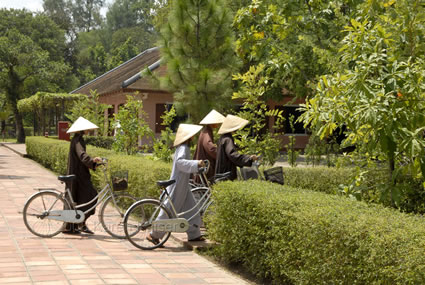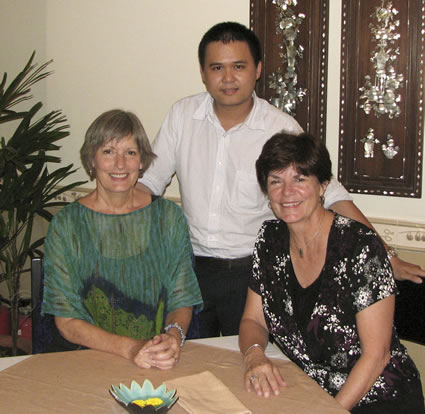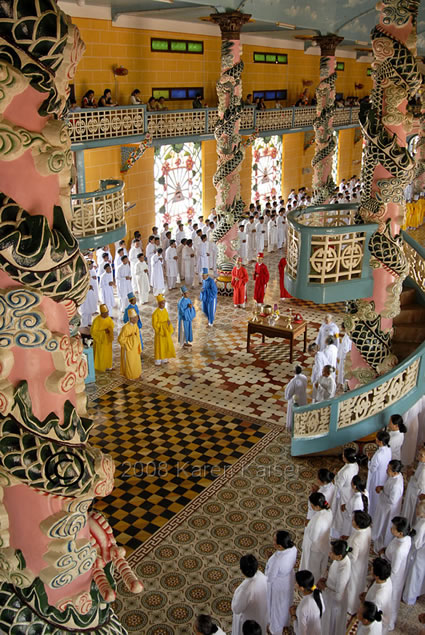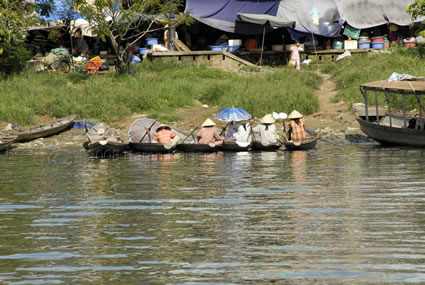Traveling Through Vietnam 30 Years
Later
as a Senior
Article and Photos by
Karen Kaiser

|
|
Ha Long Bay, Vietnam.
|
Vietnam is truly an exotic destination
that has turned up on many travel itineraries in recent
years and lies next door to Cambodia and Laos. I had lived
in Vietnam in the mid-1970s and wanted to go back to photograph
Tet Trung Thu — the Children's Festival — a holiday
for children that I remembered celebrating, featuring colorful
balloons and lanterns, special toys, moon cake, and parades. I
also wanted to see more of the country, something that I
was unable to do during my previous experience in Vietnam.
Nancy, my good friend, travel buddy, and fellow photographer
agreed to accompany me. The plan was to be in
Ho Chi Minh City a few days prior the fall festival, when the festival activities were to occur, then
tour the country, ending up in Hanoi.
Planning
We knew that it was going to
be important for us to be able to move around independently
and that a preplanned, “by the number” tour
would not give us the flexibility that we wanted in terms
of travel dates. We also decided that, although
we are well-traveled, somewhat adventurous women “of
a certain age” who have traveled solo in other
countries, we wanted a guide in Vietnam to help us with
the language. Also, having a guide would enable
us to make efficient use of our time in-country by eliminating
the need for us to find our way to important sites on
our own.
Enter the Internet, where I became
my own travel consultant and discovered Haivenu UK Limited,
an in-country tour company that proved to be just what we
needed. My query, outlining our basic ideas for the trip,
was soon answered by Mrs. Nguyen Thu Hang, who suggested
an itinerary. Mrs. Hang was very prompt in responding to
all of our questions and in making requested changes to
our initial proposal. She provided references for Haivenu
upon my request and obtained our government-issued visa
approval letter for us. The booking process was fast and
easy — all on-line — even making payments
was simple.

|
|
Young Monks, Hue, Vietnam
|
Our final itinerary would take us from
Ho Chi Min City to Hanoi via Hoi An, Hue, My Son, the DMZ, ethnic
villages, the Vinh Moc tunnels, as well as two days on Ha
Long Bay in a gorgeous junk boat where we would spend one
night. The price included two in-country flights, a private,
air conditioned car with a driver and a bi-lingual, English-speaking
guide at each location, several day trips, transportation
to and from airports and hotels (all of which were pleasant
and well located), and all breakfasts and some dinners at
each location. When in one locaton for several days, we
were free to explore on our own with the assurance that Haivenu was
available for help if we needed them. Per person cost was
just over $2,000 for 15 days.

|
|
Author and friend Nancy with
their guide.
|
Getting
To Vietnam and Back
For international flights, of course,
we were on our own. Once again, the Internet helped us find
the travel arrangements that best suited our needs. We used Expedia to
book our out-bound flight from Dulles International Airport
into Ho Chi Min City and our return flight out of Hanoi back to Dulles
through Seoul, Korea on Korean Air both ways. This route
offered the shortest overall time (21 hours + 1 day) at
the best price — about $1,450.00 per person. It
was slightly more expensive, but arriving and departing
from different cities created a more time-efficient schedule.
The Korean Air jet
offered increased leg room and individual entertainment
systems in coach, two features that helped us endure the
14+ hour flights. Inchon Airport offers a transit lounge
where you can sleep, eat, and/or have a relaxing massage
in a full-service spa - a very nice, if expensive, way to
spend a four-hour layover. My sixty-minute leg and body
massage cost $88.00 US.
Challenges and Successes
One of the pleasures of travel
abroad is being able to speak to people in their own
language. Although I remembered some of the language,
re-learning Vietnamese was a daunting task. It is a monosyllabic
language with tones that are almost impossible for westerners
to distinguish and yet are critical to being understood. For
example, the word tam can mean either “bath” or
the number “eight”, depending on the tone.
Nevertheless, we did manage to learn numbers plus basic
words and phrases. The reward was that by breaking the
language barrier somewhat, we demonstrated to locals
our willingness to connect with them. Natives then helped
us learn more of the language with their characteristic
Vietnamese charm. In addition, the pushiest vendors left
us alone immediately when we told them “no” in
Vietnamese! And, yes, there were good-natured giggles
all around when we really butchered the language.
As photographers, we never felt hampered
or uncomfortable with cameras around our necks. Surprisingly,
religious ceremonies like the one at the Cao Dai Holy See
in Tay Ninh, did not prohibit picture taking. Although
some made it clear that they did not wish to be photographed
(an attitude we respected) most of the friendly, smiling
Vietnamese people were as wonderfully cooperative with us
as with their friends... and everybody seems to have a camera
(or at least a cell phone with one).

|
|
Ceremony, Cao Dai Holy See, Tay
Ninh, Vietnam.
|
Keeping in touch with friends and family
at home was easy. Technology is up-to-date and everywhere
in Vietnam. Wireless Internet access is readily available
in hotels, restaurants, and cafes. Vietnam seems to have
jumped from the clumsy old French PTT communications system
of the 1970s straight into cyberspace. And the connections
were fast and reliable, although for some reason, we could
not send or receive calls to the U.S. on Nancy’s international
cell phone, though we could send text messages back and
forth.
When we needed cash, we found ATMs
offering instructions in English, as well as Vietnamese,
on every street corner. Most major bank cards work fine
dispensing dong (the local currency) in a variety
of amounts: 1,500,000VD equals about $58.00 USD at approximately
16,000VD to the dollar.
Prices are low throughout the country.
See Numbeo.com for comprehensive prices. A taxi ride within one district in Ho Chi Min City is less than $3.00.
A gourmet French meal at the in Hanoi with two glasses of wine and dessert is about
$35 per person. Tipping is not expected but we did tip
modest amounts in both restaurants and taxis. Tour drivers
and guides received generous amounts ($3-$5 per day) for
their good service and willingness to bend the “plan
for the day” if there was something that we especially
wanted to do or see.
Health and Safety in Vietnam
The question that I am asked
most often is whether I felt safe in Vietnam. The
State Department website lists many things to be careful
about — from malaria to street crime. My husband
feared for my safety while driving around the DMZ with
a couple of “strange men” (our guide and
driver). Others warned about the food and drinking
water. “After all”, they reasoned, “Vietnam
is nothing like Pennsylvania, where you live, and at
60+ will you be able to handle the long flights, the
jet lag and the climate along with everything else?”
Truth be told, the only thing that
did a number on me was the climate: It is hot, very humid,
and sticky. So you are often dripping with sweat, consuming
mass quantities of bottled water, and hardly ever needing
a restroom (although there are plenty available). For me,
being in air conditioning at regular intervals was paramount
to enjoying the trip. Maybe that’s just the “senior” part
of me reacting or maybe it was because we traveled during
the rainy season in September — rather than between
November through March, when it is cooler with lower humidity.
In any case, we had received the recommended
vaccinations and malaria tablets prior to departure. We
also sprayed our clothes with insect repellent and used
sunscreen. However, I do not remember seeing so much as
an ant, let alone a mosquito! We were careful to drink
only bottled water, including when brushing our teeth, and
we rested when we were tired. The food was fresh, healthy,
and delicious, and beautifully presented.
As far as feeling safe from crime, the
comfort level was very high. This is not to say that it
is not necessary to take the same precautions that you would
in any large city. It is. But when the hotel door men remind
you every time that you step outside to keep your valuables
where you can see them, it is harder to slip up. The biggest
problem that I encountered was a hotel manicurist who tried
to shame me into giving her a 100% tip! Did I say
tips weren’t expected? Well only by some.
The one time that I feared for my personal
safety was crossing the street in Ho Chi Min City. As one guidebook
put it, street-crossing is an extreme sport. There is a
trick to it and it is unnerving: You must step out into
the intersection and proceed at a slow, steady pace (as
if you were walking across your living room), looking straight
ahead and not stopping or making any sudden moves until
you get to the other side. The motorcycles and other vehicles
will then “flow” around you. I knew this was
going to take some practice when, on my first day in town,
an old woman got up from her seat on the sidewalk and took
my arm, helping me to cross. Traffic stops for no man (or
woman) in Ho Chi Min City.
Conclusion
Booking an in-country tour was the perfect
blend of independence, comfort and security. Since it was
just the two of us, we were able to get to know our local
guides on a more personal level than would have been possible
otherwise. We could also make the most of the time we had
in terms of sightseeing, making discoveries on our own and
doing the photography that we came to do. We were not
limited by a strict timetable or itinerary, just our curiosity
and energy level. For example, the Dong Ba Market, on the
edge of the Perfume River in Hue, is an authentic local
market and a great place to shop for souvenirs. Our guide
took us there, not by car, but by dragon boat. When we disembarked
at the same muddy bank that the locals use, we were greeted
with curious but welcoming smiles and stares.

|
|
Perfume River at the Dong Ba
Market, Hue, Vietnam
|
Karen Kaiser has been a serious fine
art/travel photographer since January 2000 and an avid traveler
most of her life. Having lived in Ho Chi Min City, formerly known as Saigon, from 1973-1975, she was eager to return to
see how the city had changed and also to see more of the
country — something she was unable to do 33 years ago.
|
